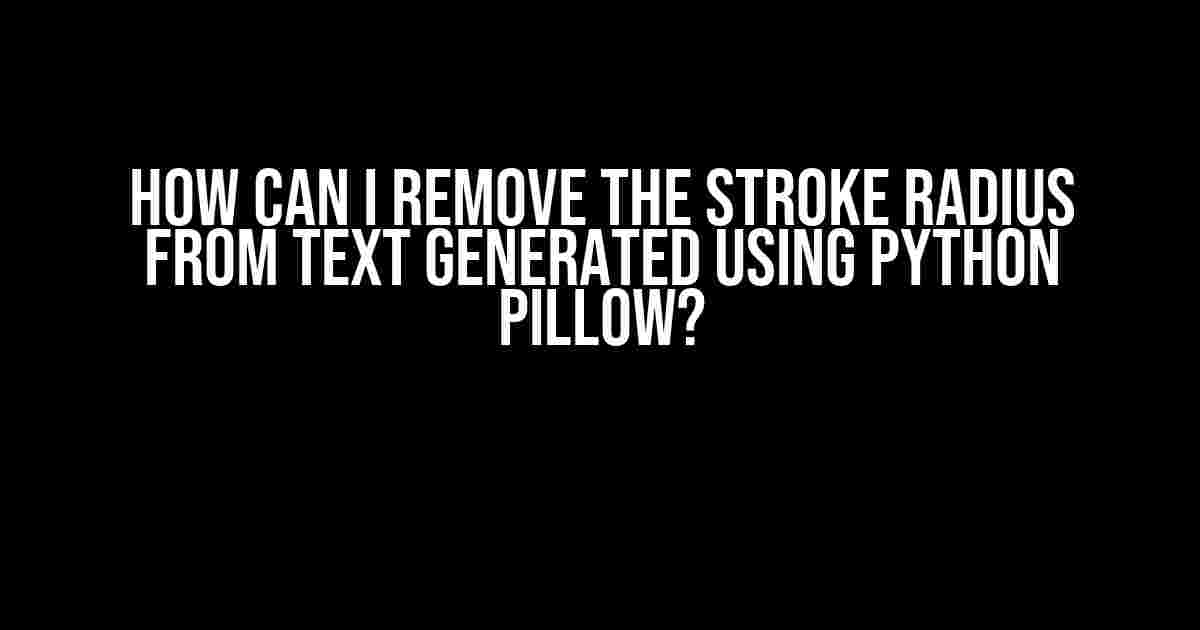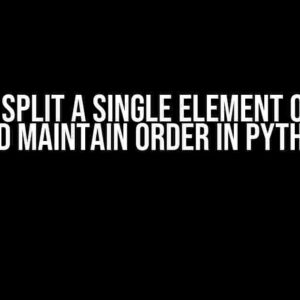Are you tired of that unwanted stroke radius ruining the clean look of your text-based designs? Well, you’re in luck because we’ve got the solution for you! In this article, we’ll delve into the world of Python Pillow and explore the easiest ways to remove the stroke radius from text generated using this powerful library.
What is Python Pillow?
Before we dive into the solution, let’s take a step back and understand what Python Pillow is. Python Pillow, also known as PIL (Python Imaging Library), is a free and open-source library for the Python programming language. It provides an easy-to-use interface for opening, manipulating, and saving various image file formats. One of its most popular features is the ability to generate text on images, which is exactly what we’ll be focusing on today.
The Problem: Stroke Radius
When generating text using Python Pillow, you might have noticed that the text has a slight stroke radius around it. This stroke radius can be useful in certain design scenarios, but more often than not, it’s an unwanted element that detracts from the overall look of your design. The question is, how can we remove it?
Method 1: Using the stroke_width Argument
The simplest way to remove the stroke radius is by using the stroke_width argument when generating text. This argument allows you to set the width of the stroke around the text. By setting it to 0, you can effectively remove the stroke radius.
from PIL import Image, ImageDraw, ImageFont
# Create an image
image = Image.new('RGB', (500, 500), color='white')
# Set the font
font = ImageFont.truetype('font.ttf', 50)
# Create a draw object
draw = ImageDraw.Draw(image)
# Generate text with 0 stroke width
draw.text((100, 100), 'Hello, World!', font=font, fill='black', stroke_width=0)
# Save the image
image.save('output.png')
In this example, we’re generating an image with the text “Hello, World!” and setting the stroke width to 0. This will produce an image with clean, stroke-free text.
Method 2: Using the stroke_fill Argument
Another way to remove the stroke radius is by using the stroke_fill argument. This argument allows you to set the color of the stroke. By setting it to the same color as the fill, you can effectively hide the stroke radius.
from PIL import Image, ImageDraw, ImageFont
# Create an image
image = Image.new('RGB', (500, 500), color='white')
# Set the font
font = ImageFont.truetype('font.ttf', 50)
# Create a draw object
draw = ImageDraw.Draw(image)
# Generate text with stroke fill set to fill color
draw.text((100, 100), 'Hello, World!', font=font, fill='black', stroke_fill='black')
# Save the image
image.save('output.png')
In this example, we’re generating an image with the text “Hello, World!” and setting the stroke fill to the same color as the fill (black). This will produce an image with clean, stroke-free text.
Method 3: Using a Transparent Stroke
A more advanced approach to removing the stroke radius is by using a transparent stroke. This method involves creating a separate image with the text and then compositing it onto the main image with a transparent stroke.
from PIL import Image, ImageDraw, ImageFont
# Create an image
image = Image.new('RGBA', (500, 500), color='white')
# Set the font
font = ImageFont.truetype('font.ttf', 50)
# Create a draw object
draw = ImageDraw.Draw(image)
# Create a separate image for the text
text_image = Image.new('RGBA', (500, 500), color=(255, 255, 255, 0))
# Create a draw object for the text image
text_draw = ImageDraw.Draw(text_image)
# Generate text on the text image
text_draw.text((100, 100), 'Hello, World!', font=font, fill='black')
# Composite the text image onto the main image with a transparent stroke
image.alpha_composite(text_image, dest=(100, 100))
# Save the image
image.save('output.png')
In this example, we’re creating a separate image for the text and generating the text on it. We’re then compositing the text image onto the main image with a transparent stroke, effectively removing the stroke radius.
Conclusion
In this article, we’ve explored three methods for removing the stroke radius from text generated using Python Pillow. Whether you’re a seasoned designer or a beginner, these methods will help you achieve clean, stroke-free text in your designs. Remember, the key to success lies in understanding the arguments and options available in the Python Pillow library. With practice and patience, you’ll be generating stunning text-based designs in no time!
| Method 1 | Using the stroke_width argument to set the stroke width to 0. |
| Method 2 | Using the stroke_fill argument to set the stroke fill to the same color as the fill. |
| Method 3 | Using a transparent stroke by compositing a separate image with the text onto the main image. |
By following these methods, you’ll be well on your way to creating stunning text-based designs with Python Pillow. Remember to experiment and explore the library’s capabilities to unlock even more creative possibilities!
Frequently Asked Questions
Q: What is the default stroke width in Python Pillow?
A: The default stroke width in Python Pillow is 1 pixel.
Q: Can I adjust the stroke radius for individual characters?
A: Yes, you can adjust the stroke radius for individual characters by using the stroke_width argument for each character. However, this can be a complex and tedious process, and it’s often easier to use one of the methods outlined in this article.
Q: Is it possible to remove the stroke radius for all text in a single step?
A: Yes, you can remove the stroke radius for all text in a single step by using the stroke_width argument when creating a font object. This will apply the stroke width to all text generated using that font object.
-
Python Pillow Documentation: https://pillow.readthedocs.io/en/stable/
-
Python Imaging Library (PIL) Tutorial: https://www.tutorialspoint.com/python/python_pil.htm
-
Removing Stroke from Text in PIL: https://stackoverflow.com/questions/56285541/removing-stroke-from-text-in-pil
We hope this article has provided you with a comprehensive guide to removing the stroke radius from text generated using Python Pillow. If you have any further questions or need assistance, feel free to ask!
Frequently Asked Question
Pillow, the popular Python imaging library, can sometimes leave you with an unwanted stroke radius around your text. Don’t worry, we’ve got you covered! Here are the most frequent questions and answers on how to remove the stroke radius from text generated using Python Pillow.
Can I simply set the stroke width to 0?
Unfortunately, setting the stroke width to 0 won’t remove the stroke radius entirely. You’ll still see a faint outline around your text. But don’t worry, there are other ways to remove it!
How can I remove the stroke radius using the `ImageDraw` module?
You can remove the stroke radius by not specifying the `outline` parameter when using the `ImageDraw.text` method. This will render the text without any stroke radius. For example: `draw.text((x, y), text, font=font, fill=color)`. Easy peasy!
What if I want to keep the stroke, but remove the radius?
In that case, you can set the `outline` parameter to the same color as the text fill color. This will make the stroke radius effectively disappear. For example: `draw.text((x, y), text, font=font, fill=color, outline=color)`. Voilà!
Can I remove the stroke radius when using a custom font?
Yes, you can! The trick is to load your custom font using `ImageFont.truetype` and then use the `font.getsize` method to get the text dimensions. After that, you can use the `ImageDraw.text` method without specifying the `outline` parameter. Easy!
Are there any other ways to remove the stroke radius?
Yes, there are! You can also use the `ImageDraw.textsize` method to get the text dimensions and then draw the text multiple times with slight offsets to create a “fake” stroke effect. This method requires a bit more code, but it gives you more control over the text rendering. Happy coding!



